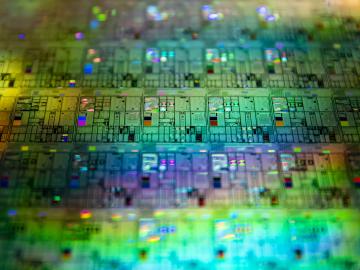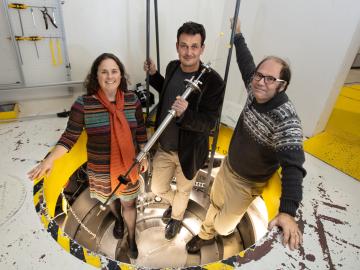
Filter News
Area of Research
- (-) Neutron Science (35)
- (-) Supercomputing (55)
- Advanced Manufacturing (6)
- Biology and Environment (22)
- Computational Engineering (1)
- Computer Science (8)
- Electricity and Smart Grid (1)
- Energy Science (94)
- Functional Materials for Energy (1)
- Fusion and Fission (6)
- Fusion Energy (2)
- Isotope Development and Production (1)
- Isotopes (2)
- Materials (93)
- Materials Characterization (1)
- Materials for Computing (18)
- Materials Under Extremes (1)
- National Security (17)
- Nuclear Science and Technology (7)
- Quantum information Science (9)
- Transportation Systems (2)
News Topics
- (-) Machine Learning (17)
- (-) Materials Science (33)
- (-) Molten Salt (1)
- (-) Quantum Science (30)
- (-) Transportation (10)
- 3-D Printing/Advanced Manufacturing (10)
- Advanced Reactors (2)
- Artificial Intelligence (40)
- Big Data (23)
- Bioenergy (14)
- Biology (16)
- Biomedical (28)
- Biotechnology (2)
- Buildings (4)
- Chemical Sciences (7)
- Clean Water (2)
- Composites (1)
- Computer Science (99)
- Coronavirus (19)
- Critical Materials (3)
- Cybersecurity (9)
- Energy Storage (14)
- Environment (29)
- Exascale Computing (26)
- Fossil Energy (1)
- Frontier (33)
- Fusion (2)
- Grid (5)
- High-Performance Computing (44)
- Hydropower (1)
- Isotopes (2)
- Materials (28)
- Mathematics (2)
- Microscopy (8)
- Nanotechnology (19)
- National Security (8)
- Neutron Science (122)
- Nuclear Energy (7)
- Partnerships (1)
- Physics (17)
- Polymers (3)
- Quantum Computing (20)
- Security (7)
- Simulation (16)
- Software (1)
- Space Exploration (5)
- Summit (43)
Media Contacts

Scientists have tapped the immense power of the Summit supercomputer at Oak Ridge National Laboratory to comb through millions of medical journal articles to identify potential vaccines, drugs and effective measures that could suppress or stop the

For the second year in a row, a team from the Department of Energy’s Oak Ridge and Los Alamos national laboratories led a demonstration hosted by EPB, a community-based utility and telecommunications company serving Chattanooga, Tennessee.

In the early 2000s, high-performance computing experts repurposed GPUs — common video game console components used to speed up image rendering and other time-consuming tasks

In the race to identify solutions to the COVID-19 pandemic, researchers at the Department of Energy’s Oak Ridge National Laboratory are joining the fight by applying expertise in computational science, advanced manufacturing, data science and neutron science.

We have a data problem. Humanity is now generating more data than it can handle; more sensors, smartphones, and devices of all types are coming online every day and contributing to the ever-growing global dataset.

An international team of researchers has discovered the hydrogen atoms in a metal hydride material are much more tightly spaced than had been predicted for decades — a feature that could possibly facilitate superconductivity at or near room temperature and pressure.

A team from the ORNL has conducted a series of experiments to gain a better understanding of quantum mechanics and pursue advances in quantum networking and quantum computing, which could lead to practical applications in cybersecurity and other areas.

Scientists at have experimentally demonstrated a novel cryogenic, or low temperature, memory cell circuit design based on coupled arrays of Josephson junctions, a technology that may be faster and more energy efficient than existing memory devices.

ORNL computer scientist Catherine Schuman returned to her alma mater, Harriman High School, to lead Hour of Code activities and talk to students about her job as a researcher.

Scientists at the U.S. Department of Energy’s Brookhaven National Laboratory have new experimental evidence and a predictive theory that solves a long-standing materials science mystery: why certain crystalline materials shrink when heated.


